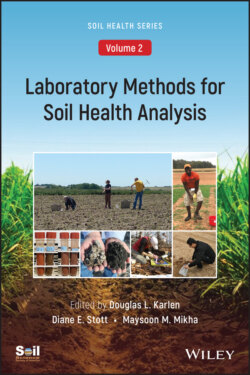Читать книгу Laboratory Methods for Soil Health Analysis, Volume 2 - Группа авторов - Страница 35
Visual Soil Evaluations
ОглавлениеVisual soil evaluations are important components of soil health assessment. If done thoroughly and in a quantitative manner, visual soil evaluations can be integrated with broader land evaluation frameworks (Mueller et al., 2012; Pellant et al., 2020). As there are multiple soil evaluation methods currently in use (Ball and Munkholm, 2015), evaluators need to mindful of their intended application and respective strengths and weaknesses. The Visual Evaluation of Soil Structure (VESS) (Ball et al., 2017) and rangeland health assessment protocols (Pellant et al., 2020) represent approaches for cropland and rangeland, respectively.
The VESS was designed for arable production systems (Ball et al., 2017) based on the Peerlkamp Spade Test (Peerlkamp, 1959). It classifies top‐ and sub‐soil attributes into five scoring categories based on the size, shape, and visible porosity of soil aggregates, rooting characteristics, and presence/absence of macropores. VESS requires only a shovel and scoring guidelines (Scotland’s Rural College, 2019), so evaluators can quickly assess soil structure and assign a score between 1 (best) and 5 (worst). The tactile “hands‐on” nature of VESS enables it to work best when the soil is in a friable condition (neither too wet nor too dry). A limitation of VESS is that it does not work well in very sandy soils because of low structural cohesion (Franco et al., 2019).
The VESS has been used globally across a broad range of soil types and production systems to discern management impacts on soil health (Munkholm and Holden, 2015). The scores have also been correlated to various soil physical properties, soil‐atmosphere gas fluxes, and crop yield (Ball et al., 2017), thus confirming its value for soil health assessment.
Rangeland health assessments using three interrelated ecosystem attributes of soil/site stability, hydrological function, and biotic integrity (Pellant et al., 2020) have been shown to help characterize the status and trends of critical soil functions and effectively guide changes in management (Brown and Herrick, 2016). Using a combination of qualitative and quantitative indicators, Pellant et al. (2020) developed criteria for monitoring rangeland health using 17 indicators that include soil‐related evaluations of bare ground, gullies, resistance to erosion/degradation, and compaction. Rangeland health assessments using these criteria have been adopted by public agencies and private landowners throughout the world and have served to improve the systematic understanding of soil quality in rangeland ecosystems (Brown and Herrick, 2016). Effective use of rangeland health assessments, however, requires the evaluator to recognize and correctly identify site characteristics including landscape and temporal variability since evaluations are made relative to an ecological site or its equivalent.
